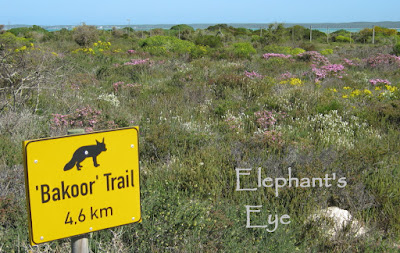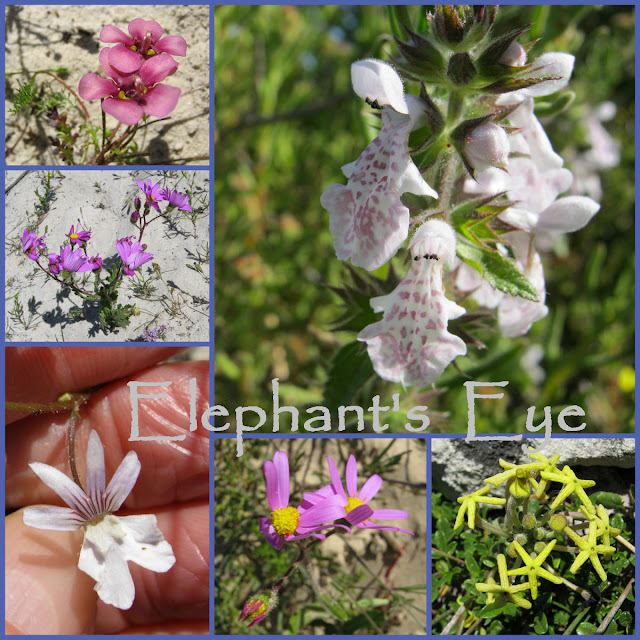Have you seen this Iris?
By Diana Studer
- gardening for biodiversity
in Cape Town, South Africa
We explored the hiking trails thru the spring flowers at the
West Coast National
Park in September 2010. When I go walking I want to stop, and watch bugs, and
photograph flowers. Take my time, and enjoy myself. There are cycling trails of
30 or 70 km, or 13 km on a mountain bike. Hiking trails are one or two days –
but we chose the Bakoor Trail, just 4.6 km.
That was the day I stepped down the slope onto some round pebbles. My foot shot out, my leg folded wrong, then I landed on that leg in a crumpled ungainly heap. Carefully protecting my brand new camera! (I MISS that camera). So I limped along the rest of the trail. While we were gazing at flowers a mole-snake rumbled indignantly past our feet.
Patterns and textures. Lime green of Euphorbia mauritanica
flowers, soft fluffy white cotton-bolls on wild rosemary Eriocephalus,
and bushes in a subtle range from grey to green.
Don’t remember seeing these Flanders fields red poppies
growing wild before (now they flourish in our False Bay garden). Must have come
as a ‘bonus’ in the sacks of wheat seeds. Weird three winged seed head … Zygophyllum
morgsana (toxic to man and beast, but the common name is slaaibos,
salad-bush!) Those elaborately formed purple drum sticks are Zaluzianskya.
When I first worked at the Engineering and Science Library at the University of
Cape Town, a girl came to ask – she’s doing invitations for her friend’s
wedding. Wants to draw these flowers, do I know what they are? Zaluzianskya
villosa, common name Drumsticks.
The Bakoor Trail starts just inside the gate. Skirts the
edge of the sand-dune. Up the steep slope where we saw the dung-beetle
DETERMINED to push his ball UP the slope, rolled down into our footprints, and
up the slope again. Tiny Sisyphus!
Ursinia anthemoides with two tone yellow petals, and
a dark heart. Buttery yellow Arctotis? Yellow daisy with magnificent
seeds which outshine all the other flowers, Tripteris?
The Bakoor Trail winds up to the top of Seeberg, with a
wonderful view across spring flowers and Langebaan Lagoon to the ocean.
Magenta Senecio arenarius. Foxglove spots … Stachys
aethiopica (sage family, aethiopica that country called Africa,
south of the known world). Tiny corrugated yellow star Lyperia, Nemesia
bicornis ‘from Namaqualand to Riversdale’ and pink Diascia capensis ‘with
two yellow pouches’. All but the Senecio and Stachys are in
Scrophulariaceae (along with that Zaluzianskya and your foxgloves).
There was a blustery breeze, so this Senecio has her
hair blown all over the place. Quite a few fingers in the pictures, as I had to
hold the flowers steady.
We've seen Satyrium planted in Ramskop-wildflower-garden,
but these are Stop Stop growing wild. One slightly battered Moraea tripetala,
a hand high miniature replica of OTT florist’s iris. And what is this?
Have you seen an Iris family member who looked like this?
Grows tall too, winding up in the support of a bush. Ferraria crispa.
Bizarre no? But rather beautiful in a weird way. Seen as we headed down to the
bird hide on the edge of the salt marsh.
Check West
Coast Flower Update to see how the flowers are before you plan your journey.
We found fresh flowers
in 2014.
I invite you to join us at Elephant's Eye on False Bay. Please subscribe as you prefer
- Email via Feedburner,
or Feedly,
or Bloglovin,
or Facebook
Pictures by Diana and Jurg Studer
of Elephant's Eye on False Bay
(If you mouse over teal blue text, it turns seaweed red
Those are my links.
To read or leave comments, either click the word Comments below,
or click this post's title)
I invite you to join us at Elephant's Eye on False Bay. Please subscribe as you prefer
- Email via Feedburner,
or Feedly,
or Bloglovin,
or Facebook
Pictures by Diana and Jurg Studer
of Elephant's Eye on False Bay
(If you mouse over teal blue text, it turns seaweed red
Those are my links.
To read or leave comments, either click the word Comments below,
or click this post's title)











such amazing photos, like nothing I would ever see, almost alien to me, from another planet, mother nature never ceases to amaze me with the never ending array of plants, in every color size and shape imaginable,
ReplyDeleteI'm glad you didn't injure your self worse than you did and I hope that no lasting injury persisted,
The camera survived, and only my dignity was hurt looking back.
DeleteIt must be a fabulous sight, all of those blooms growing naturally in the wild. A spectacular view across the lagoon too.
ReplyDeleteLovely shots of nature. I love that field of yellow daisies.
ReplyDeleteIt's amazing the flowering plants you c an see if you take the time to look at your feet. Never mind the namaqualand daisy display - Mother Nature has more than that brief moment to share :)
ReplyDeleteI am amazed at the flowering plants I see here - they are completely invisible from the N2.
walking slowly with a camera it always amazes me quite how much variety there is in our fynbos.
DeleteGlad to hear the camera survived! Your photos are amazing.
ReplyDeleteA while back, I stumbled over some roots and, in that split second realizing I was falling, I debated how to do the least damage to the camera--hold it or toss it. I tossed it and it survived better than I did.:)
I held the camera up like a torch - then had only one hand to rescue myself.
DeleteI haven't seen an Iris like that before. It is certainly very strange looking. I don't think I would want it growing in my garden but it's nice to come upon it in the wild like that.
ReplyDeleteIt is odd, but in life it is dramatic and striking.
DeleteIt's amazing how many different and beautiful flowers there are out there and I bet most people miss them when they walk there. Hope your leg is doing ok.
ReplyDeleteYes thanks, a couple of days and I was OK.
DeleteWe pride ourselves on the spring wildflowers, especially in the Columbia River Gorge, but you have us beat by a wide margin. Do they seem exotic to you? There are certainly quite a few like nothing I've seen before.
ReplyDeleteOur fynbos has a huge variety of plants, and many endemics.
DeleteEach walk I come home with a bundle of pictures and dig thru my books and websites to name the flowers.
Every time it daunts me and there are some I can't find names for.
Diana, I always see so many intriguing new flowers on your blog. I'm not sure I'd want that iris in my garden (it looks somehow sinister), but it is very interesting. -Jean
ReplyDeletethe colour IS sombre, but I like dark drama in a garden - my Prunus nigra is leafing out.
DeleteYou live in such a colorful world, it's all there to be captured with the camera if only the eye is willing to see it.
ReplyDeleteThe shapes of your flowers, the seed pods...what fun it would be to wander and take a million shots.
Jen
You have some very beautiful blooms there, and like Jen said, they come in a nice variety of shapes. I hope your leg has healed up. Thanks for your comment on my Wildflower Wednesday post. Yes, I am enjoying the seed heads almost as much as what we have left blooming.
ReplyDeleteWe have several members of the Scrophulariaceae family in this part of the world, Diana, including penstemons, verbascum, veronica (speedwell), and foxgloves. Our Senecios are ragwort causing allergies and hayfever. Somehow they all look so much more exotic in your locale. P. x
ReplyDeleteI like to walk short walks and have time to look at everything, except sometimes I like to power along too. These days prefer not to have to conform to a group. What a wonderful NP. My favourite photo is the subtle tapestry of colour.
ReplyDeletestill planning to join a botanising group for me (so MANY flowers to name)
Deleteand a hiking group for him to power along with.
Dear Diana,
ReplyDeleteevery single post an adventure, a lesson in new and interesting things. That's why I love to visit your blog.
Your new profile pictures is so lovely!!! Thank you so much for your charming words.
Happy days
Elisabeth
A wildflower dispay more beautiful than that planted by a gardener! The wild rosemary is amazing; it looks like a cross between Rosmarinus officials and the cotton plant that is one of my state's big cash crops.
ReplyDeleteI cannot get enough of your wild flowers...that is an unusual flower indeed but I have never heard of a bat-eared fox...must be amazing to see.
ReplyDeleteWe watched them hunting in the Kgalagadi. Insect eaters, they hunt with their ears focused to sweep the ground.
Delete